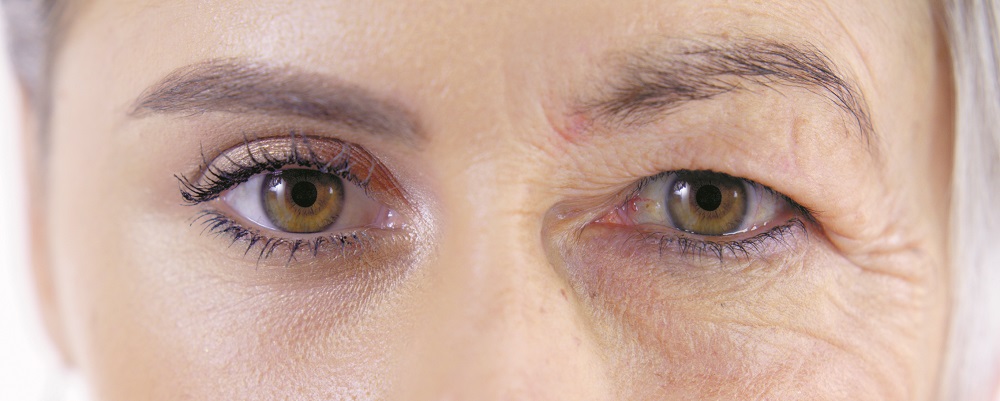If you’ve noticed that your eyelids are looking a little droopy as you age, you’re not alone. Two different conditions can cause this common sign of aging—which can be merely cosmetic or interfere with your vision—and both are treatable.
Ptosis. Ptosis (toh-sis) refers to a falling or dropping. When it applies to the eyelid, it is called blepharoptosis (blef-a-rop-toh-sis) drooping. Bleph means eyelid. It is caused by an issue with one or both of the muscles that lift the eyelid. Some people are born with it, while others develop it with age or as the result of trauma. The most common form is involutional blepharoptosis. This is primarily age-related and occurs due to the stretching, weakening, or separation of the muscles responsible for lifting the eyelid.
Less often, ptosis may be the result of a structural abnormality (such as a cyst), a neuromuscular disorder, or trauma from accidents, surgeries, preferentially sleeping on one side, sleeping in contact lenses, or repeated eye injections.
Several medications have been reported to potentially cause or contribute to ptosis as well. (See sidebar.)
Dermatochalasis. Another cause of droopy eyelids is excess skin or fat (dermatochalasis [derm-ay-toe-kuh-lay-sis]) on the lid.
Treatment
These conditions can occur together or separately, but they have different treatment options.
If you need muscular repair, you would see an oculofacial plastic surgeon—an ophthalmologist who has also trained in plastic surgery. If you have excess skin, an oculofacial plastic surgeon, ophthalmologist, or general plastic surgeon could perform a procedure called blepharoplasty to remove it. If you have both conditions, the oculofacial plastic surgeon can address both in a single surgery. The risks of surgery are scarring, asymmetry, dry eye, and in rare cases, a bleed that can cause vision loss.
Eye drop for droopiness
There is also a prescription eye drop, oxymetazoline hydrochloride ophthalmic solution 0.1% (Upneeq), that temporarily improves droopy eyelids for people with acquired blepharoptosis. Oxymetazoline hydrochloride is the same primary ingredient in decongestant nasal spray, such as Afrin. In nasal spray, it causes blood vessels to contract. In Upneeq, it causes an involuntary eyelid muscle to contract.
In clinical studies, the drop lifted the eyelid by an average of 1 millimeter for about six hours. Side effects may include eye inflammation or irritation, redness, dry eye, blurred vision, headache, inflammation of the cornea, and eye pain. Upneeq may affect blood pressure and may interfere with some prescription medications, including antihypertensive medications, beta-blockers, cardiac glycosides, and monoamine oxidase inhibitors.
Both conditions are normally considered to be cosmetic, so insurance doesn’t cover care unless the eyelid is so droopy that it impairs vision and affects activities such as driving or reading.
Medications That Mat Cause Eyelid Drooping
Muscle relaxants: Medications such as baclofen, used to treat muscle spasms and spasticity, can occasionally cause ptosis as a side effect.
- Antihypertensive drugs: Some blood pressure medications, particularly alpha-adrenergic blockers like clonidine or methyldopa, have been reported to cause ptosis in rare cases.
- Antidepressants: Certain antidepressant medications, including tricyclic antidepressants like amitriptyline or selective serotonin reuptake inhibitors (SSRIs) like fluoxetine, have been associated with ptosis as a potential side effect.
- Antipsychotic medications: Some antipsychotic drugs, such as chlorpromazine or haloperidol, have been linked to the development of ptosis.
- Anti-Parkinson’s medications: Certain drugs used in the treatment of Parkinson’s disease, like levodopa or dopamine agonists (e.g., pramipexole, ropinirole), have been reported to cause ptosis in some individuals.
- Ophthalmic medications: Certain eye drops or ophthalmic medications, particularly those containing beta-blockers (e.g., timolol) or prostaglandin analogs (e.g., bimatoprost), can occasionally lead to ptosis as a local side effect.


